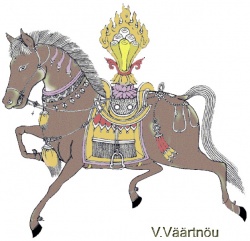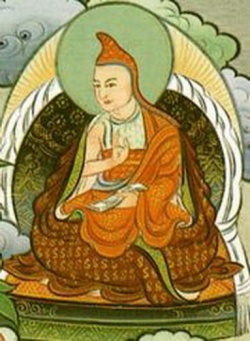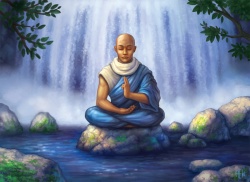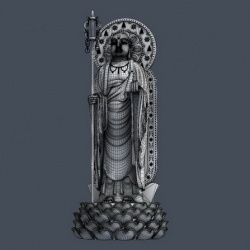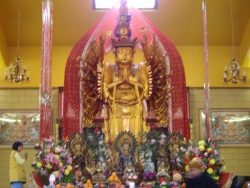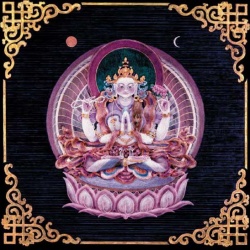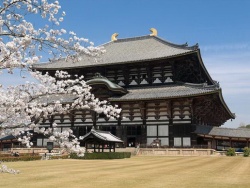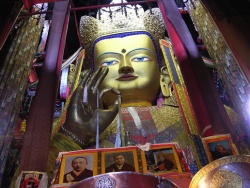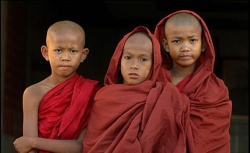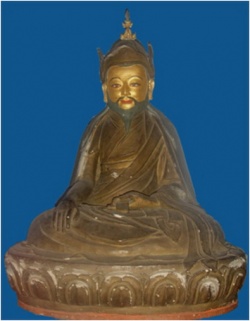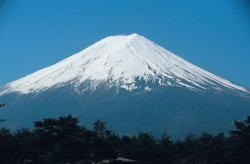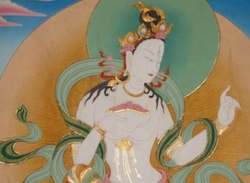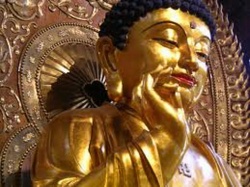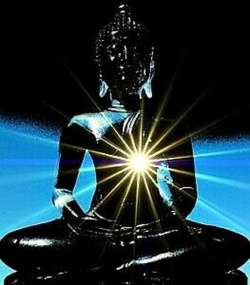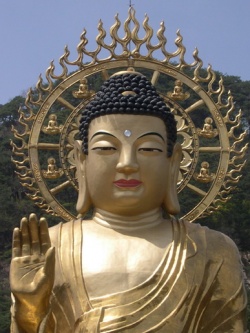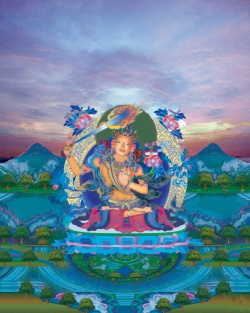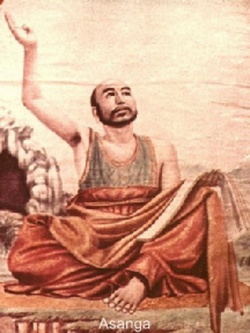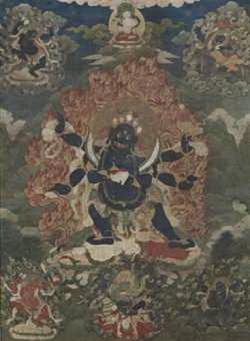Elements of Hwa-eom Faith and Philosophy in Korean Buddhist Ritual Invocations: Emphasis on the Main Hall Liturgy
Ven. Hae-ju
(Ho-ryeon Jeon)
This paper will examine elements of Hwa-eom (Avatamsaka) faith and philosophy, in particular the ‘Main Sanctuary’ ritual in Seongmun uibeom (釋門儀 範: The Book of Buddhist Liturgies). Daily recital of Buddhist liturgy in the main sanctuary of the temple has been a central aspect of monastic training and discipline since the Later Silla period which might suggest that contemporary modes of worship and discipline are even today influenced by the original Hwa-eom texts used in worship. And since Hwa-eom has continued to exert influence from this Later Silla period, it would seem important to know something of this philosophy in order to truly understand Korean Buddhism. So here we will take a look at Hwa-eom faith and philosophy from the perspective of its possible impact on the contemporary Korean Buddhist rituals and liturgies.
① Among the many summarized versions of the Flower Garland Sutra, it is the Eighty Volume Avatamsaka which is the central text for teaching and worship.
② Vairocana Buddha of Pure Dharma Body was worshipped as the progenitor and head of Avatamsaka Buddhism. Vairocana is the main Buddha in the Flower Ven. Hae-ju (Ho-ryeon Jeon) is a Professor of Buddhist Studies of Dongguk University, Korea. International Journal of Buddhist Thought & Culture September 2007, Vol.9, pp.33-59.
ⓒ 2007 International Association for Buddhist Thought and Culture Ven. Hae-ju (Ho-ryeon Jeon): Elements of Hwa-eom Faith and Philosophy Garland Sutra, and is one-and-the-same as Rocana and Sakyamuni in the Trinity of the Three Buddhas.
③ In the “Lotus Realm” chapter of the Eighty Volume Avatamsaka, we can clearly see the intent to reach the Lotus Realm of Perfumes (Pure Land); here the World Ocean of the Great Lotus Realm is described.
④ The Hwa-eom dharma-realm is synonymous with the World of Dharma-nature, meaning that the Ocean of Dharma Nature where the Future Buddha appears is not different from the Dharma Realm.
⑤ The Infinite Dharma Realm is synonymous with the entire world.
⑥ The Hwa-eom World of the Dependent-Arising Dharma realm is considered a place where cause and effect merge together, and are not separate.
⑦ Young Sudhana is worshipped along with 53 divine deities, and the deeds of Samantabhadra are revered as the blueprint for the Way of the Bodhisattva.
⑧ There is recognition of the simultaneous discipline of Buddhahood by Past Transmission, and Buddhahood in a Single Lifetime. Thus, in Hwa-eom thought on achieving Buddhahood accepts as a goal for ordained practitioners, both Buddhahood by Past Transmission as described in the ‘Dharma Nature Hymns,’ as well as endeavoring to apply training and discipline to achieve Buddhahood in a Single Lifetime.
⑨ The teaching, “everything comes from mind,” is a revelation arising from the Flower Garland Realm.
⑩ Understanding of Hwa-eom as the Single Vehicle Teachings. This paper has outlined components of Hwa-eom faith and philosophy according to the manner they are contained in the “Main Hall Liturgies” in The Book of Buddhist Liturgies. The liturgies currently in use by Korean Buddhist congregations clearly reflect the holistic nature of Korean Buddhism, and in this regard, the “Main Hall Liturgies” are no exception. Here I want to stress again the strong Hwa-eom influences evident in the “Main Hall Liturgy,” and even go so far as to confirm that the Buddhas or the Three Treasures, which are revered in Korea, are indeed the Buddha or the Three Treasures of Hwa-eom faith. If I am correct in this then it’s reasonable to claim that the rituals and everyday discipline of Korean Buddhism have for centuries, been sheltering under the Hwa-eom umbrella.
Key words: Korean Buddhist Ritual Invocations, Main Hall Liturgy, Hwa-eom Faith and Philosophy, Seongmun uibeom, Book of Buddhist Liturgies.
I. Preface
All religions are supported by three pillars: founder, doctrine, and organization. Buddhism is no exception in this regard, a tripartite model emphasizing Three Treasures: Buddha (founder), Dharma (doctrine), and Sangha (clergy). These three constituents are also objects of faith such as the example of the ritual “Homage to the Three” which originated in the Buddha’s time and is still observed by newcomers to a Buddhist order. From early times as Buddhism became more widespread organized rituals emerged, with officially sanctioned forms which have given shape to universally recognized rituals of reverence and worship and have been useful for propagating Dharma and maintaining the integrity of the Sangha. These forms have been passed down for generations (Takasaki 1993: 13-50). In time, certain forms and rituals came to be associated with the ceremonial norms of particular traditions. Yet all rituals and invocations adopted by the various Buddhist traditions must nevertheless reflect core Buddhist principles.
It is not surprising therefore, that there are a number of rituals and ceremonial forms which are universally recognized and inclusive in all Buddhist traditions regardless of the vast regional and cultural differences. Standardization of core ritual forms is essential to the maintenance of unified Buddhism and an indispensable philosophical and faith foundation for dissemination of the Buddha’s teachings.
This paper will examine elements of Hwa-eom (Avatamsaka) faith and philosophy, in particular the ‘Main Sanctuary’ ritual in Seongmun uibeom (The Book of Buddhist Liturgies). Daily recital of Buddhist liturgy in the main sanctuary of the temple has been a central aspect of monastic training and discipline since the Later Silla period which might suggest that contemporary modes of worship and discipline are even today influenced by the original Hwa-eom texts used in worship. And since Hwa-eom has continued to exert influence from this Later Silla period, it would seem important to know something of this philosophy in order to truly understand Korean Buddhism. So here we will take a look at Hwa-eom faith and philosophy from the Ven. Hae-ju (Ho-ryeon Jeon): Elements of Hwa-eom Faith and Philosophy perspective of its possible impact on the contemporary Korean Buddhist rituals and liturgies.
II. Modern Korean Buddhist Liturgy
1. The Book of Buddhist Liturgies and Main Sanctuary Ritual All contemporary teachings of Korean Buddhism can be traced to a single text known as Seongmun uibeom1 which was first published somewhere round 1931-35 edited by An, Jin-ho, and reviewed by Gwon Sang-ro and Kim Dae-eun.2 Excerpts from Seongmun uibeom have been published in several forms, including Invocations for Lay Believers’, Acolyte’s Catechism, and Collected Liturgical Interpretations.
Seongmun uibeom is a considerable collection of liturgies and ceremonial forms presented in two volumes. The first contains liturgies, invocations, incantations, ritual offerings, and memorials; while the second is divided into 13 distinct sections: (1) “Buddhist Services,”
(2) “Memorial Services for the Dead,”
(3) “Sending the Deceased,”
(4) “Eye Opening,”
(5) “Moving the Sacred,”
(6) “Receiving the Precepts,”
(7) “Funeral Ceremony,”
(8) “General Things,”
(9) “Releasing Life,”
(10) “Chanting,”
(11) “Letters,”
(12) “Lyrics,” and
(13) “Mysteries.”
The first section of the Upper volume refers to the liturgies essential for main sanctuary worship, but also for other locations. There are eight liturgies prescribed: “Fragrant Water Rite,” “Offering of Penance,” “Rite for Seven Places and Nine Sermons,” “Rite of the Divine Four,” “Rite introducing the Buddha Lecture,” “Greater Penance Offering” and “Invocation to Avalokitesvara.” The “Offering of Five Perfumes” is used regularly in 1 Although 1931 is considered to be the first date of printing, in the Foreword 1935 is mentioned. See Jeonggak (1996: 106).
2 In Comprehensive Archive of Korean Buddhist Rituals, Park, Se-min presents a collection of 124 volumes and 74 different chanting and ritual texts used in Korean Buddhism prior to Seongmun uibeom. he also includes bibliographical information about these texts. morning and evening ceremony. The “Fragrant Water Rite” and “Rite of the Divine Four” are both used as supplementary practices for special ceremonies, and in the ceremony for transmission of the deceased spirit and for special meditation sessions. The Great and Lesser versions of “Offering of Penance” are recited at formal meals, while “Invocation to Avalokitesvara” is recited for the delivery of sermons on Avalokitesvara. “Rite for Seven Places and Nine Sermons” is also used in Hwa-eom ceremony, and the “Introductory Rite for a Buddhist Lecture” is used to initiate sessions in the lecture halls (Kim, Wol-un 1991: 34).
The term “ritual” in Buddhism doesn’t mean doctrine and religious discipline but refers to acts of worship conducted before images of Buddhas and Bodhisattvas. These rituals are further divided into daily rites and specialized ceremonies (Kim, Wol-un 1991: 10), individual liturgies and commissioned rites (Hong 1991: 25).3 In the bibliography to Comprehensive Archive of Korean Buddhist Rituals there are three categories of rituals namely, individual worship, commissioned rites, and special ceremonies: The Individual Liturgies include all rites pertaining to an individual’s religious progress, including rituals for Self-discipline, Reparation, Benefaction, and Receiving the Precepts. Other rites pertinent to the individual include veneration and daily rituals such as, Daily Incantations, Daily Rites and Offering Penance to the Patriarch. Commissioned Rites are conducted by a priest on request for lay believers and include prayers for divine intervention and benefaction.
The majority of Buddhist rituals are the commissioned. Rituals such as Spirit Mountain Transmission, Transmission to the Lord of the Dead, General Transmission, Land and Water Creatures Transmission, and Pre-mortal Discipline, all belong to this category. In addition, there are special rituals that belong to neither of the categories above, such as the Installation Ceremony, Moving the Sacred Ceremony, and Eye Opening Ceremony. Moving the Sacred Ceremony and Eye Opening Ceremony are conducted separately for the most part, but are sometimes included within the framework of 3 “Individual Liturgies are all ritual for one’s religious practice; Commissioned Rites are forms of faith which are conducted by the priest at the request of Buddhist believers, and believers get benefit from the priest’s ritual” (Hong 1996: 14).
Ven. Hae-ju (Ho-ryeon Jeon): Elements of Hwa-eom Faith and Philosophy Commissioned Rites (Park 1993: 11-12).
The “Main Sanctuary Liturgy” is conducted on a daily basis and supports individual discipline. We might therefore anticipate that a closer scrutiny of these ritual forms and philosophy, which even today sustain basic discipline in Korean Buddhist practice, can provide a window into the foundational tenets of faith and philosophy. 2. Hwa-eom and Contemporary Liturgies and Rituals The two-volume Book of Buddhist Liturgies contains most of the rituals and ceremonies employed in Korean Buddhism today. They can be summarized as follows:
In the first chapter: “Liturgical Texts,” we find the ‘Ocean of Fragrant Water Rite’ and seven other liturgies used for prayer in the main sanctuary, including devotions to the Buddha and Three Treasures which will be explained later.
The Halls of Paradise, Hall of the Eight Aspects of Buddha’s Life, Medicine Buddha Hall, Perceive Sound Hall, Arhats Hall, Judgement Hall, Assembly of Deities Shrine, Mountain God Shrine, Kitchen God Shrine, Seven Stars Shrine, Lone Saint Shrine, Maitreya Hall, etc., are all singularly designated for devotion to various Buddhas. Paradise Hall is devoted to Amita Buddha; Eight Aspects Hall to the life of Sakyamuni Buddha; Medicine Buddha Hall to Buddha the Healer, Dragon Flower Hall to Future Buddha, and Archive Hall to the Three Treasures (Buddha, Dharma, Sangha). Reference to these different Halls suggests that Sakyamuni, Amitabha, Maitreya, and the Medicine Buddha have all been important figures in Korean Buddhism; along with the Universal Three Treasures representing the Hwa-eom realm, confirming a strong Hwa-eom influence. In Hwa-eom philosophy the “Three Treasures” exist in all Buddha-realms and “Indra’s Net” is an explicit symbol of the Flower Garland (Hwa-eom) World. Among the Bodhisattvas, Avalokitesvara of the Perceive Sound Hall and International Journal of Buddhist Thought & Culture Ksitigarbha of the Judgement Hall have been most prevalent over time. Reference to the Hall of the Arhats indicates faith in the enlightened disciples of the Buddha.
“Prayer to the Deities” which includes the 39 deities of the Hwa-eom pantheon, tells us of the induction of folk deities into Korean Buddhism, but devotion to these folk deities does not supersede faith in the Hwa-eom deities. The Hall of the Lone Saint is dedicated to Naban, those who are said to have achieved enlightenment without any assistance. The Altars of the Mountain God and the Seven Star Kings are examples of earlier Korean worship of folk gods. Sometimes these two deities are worshipped together in a single hall known as the Shrine of the Three Saints. The Monarchs Shrine is devoted either to the mythical King Cakravartin, or will honor the traditional rulers of the land where the temple is located. The Kitchen God Shrine is also from an earlier folk tradition, a window into Korean ancestors’ ancient forms of worship. Bodhisattvas and deities that are important in Korean Buddhism are mentioned daily in ceremonies where their names are recited in the liturgy. The liturgy also provides us with clues to distinctive characteristics of Korean images of Buddha and the Three Treasures which are also evident in Hwa-eom features.
The second chapter includes ‘Invocation for Practicing Seon’ which is recited during the morning ceremony; ‘Upper Altar Invocation to the Buddha’; ‘Middle Altar Invocation to the Deities’; ‘Invocations for the Living’; and ‘Invocation for the Dead.’ ‘Invocation for Practicing Seon’ consists of three parts, and in addition to being recited during morning and evening prayers, is also used to dedicate merit to others. There are obvious Hwa-eom elements in the first and the last paragraphs of the ‘Upper Altar Invocation,’ as follows: I beseech the Three Treasures of the world as infinite as Indra’s Net.
We ask the Buddha not to forsake his mercy but to kindly regard us and succor us. I now convey all the merit I have gained to the Three Places and make everything well.4 Ven. Hae-ju (Ho-ryeon Jeon): Elements of Hwa-eom Faith and Philosophy I now sincerely hope thus for all the countless followers of the Dharma Realm: that they may frolic in the Sea of the Lotus Realm, enter the great temple of Bodhi, gain audience with the Buddha and the Bodhisattvas of the Flower Garland, be smite with the light of various Buddhas and thus neutralize the countless layers of sin and gain inordinate wisdom, attain Sambodhi wisdom and repay the graces of the Buddhas, perform good Bodhisattva-deeds for many generations, and actualize all the essential teachings. I pray In The Name of the Highest Wisdom.5
The particular Buddha which is at the centre of these invocations is the Infinite of the Three Treasures World, in other words, the Buddha (Three Treasures) omnipresent in the Flower Garland Dharma-realm. The three subjects for benefaction of merits are: Sentient beings, the Bodhi, and Fruition (Attainment)―these three benefactions are actually a merger of an original ten. The last paragraph above, implores the divine to allow lay believers to go to the Sea of the Lotus Realm, (another term for the Pure Land), implying a wish to personally see the Buddha and Bodhisattvas. This should leave us with no doubt that the prayers recited daily by lay and clergy in front of the Buddha and in the Three Treasures Hall are clearly of Hwa-eom origin. The ‘Middle Altar Invocation’ is of course, also Hwa-eom. The third chapter, “Incantations” include the ‘Morning’ and ‘Evening,’ and the ‘Heart Sutra,’ and ‘Prayers for Meal Offering.’ The ‘Morning Incantation’ draws from eclectic sources which include dharani, Avalokitesvara devotion and Amita Pure Land. This Morning Ceremony also contains Hwa-eom elements like the phrase, “Ten Great Vows of Samantabhadra” (T.10.844b-846c), and also, verses from the Avatamsaka Sutra: “The limitless virtue and blessing of Samantabhadra’s great practice, I dedicate to benefit all sentient beings, May all people who are drowning in suffering quickly reach the Buddha world of infinite light,”6 “The endless forms can be counted, the 4 仰告 十方三世 帝網重重 無盡三寶慈尊. 不捨慈悲 爲作證明 (或許垂朗鑑). 上來所修佛功德海 回向 三處悉圓滿 (An: 74).
5 然後願 恒沙法界 無量佛子等 同遊華藏莊嚴海 同入菩提大道場 常逢華嚴佛菩薩 恒蒙諸佛大光明 消滅 無量重罪障 獲得無量大智慧 頓成無上最正覺 廣度法界諸衆生 以報諸佛莫大恩 世世常行菩薩道 究竟 圓成薩婆若. 摩訶般若波羅蜜 (An: 75). entire waters of great oceans can be swallowed, and empty space can even be measured; but Buddha virtue cannot be spoken.”7 And, “When my life ends, may all obstacles and pain vanish, may I meet Amita Buddha and be reborn in the Paradise world.”8
The Thousand Hands Sutra is recited at evening prayer, and the Prayers for Meal Offering, which contains ten incantations for the divine, is read during offerings and at mealtimes. There are also verses requesting rebirth in the Pure Land of the Lotus World.
The chapter on “Ritual Offerings” in Seongmun uibeom contains five transmission rites: ‘Spirit Mountain,’ ‘Lord of the Dead,’ ‘General Rite,’ ‘Land and Water Creatures,’ and ‘Pre-mortal Discipline.’ In the chapter on “Pronouncements” there are 17 announcements initiating different events. The 13 chapters of the second Volume refer to various rituals for worship: Hwa-eom, deities, Tantric, Avalokitesvara, Amitabha, Dharma Flower, Maitreya, Ksitigarbha, Arhat, Seven Stars (Big Dipper), Mountain God, Kitchen God, Dragon King, Deva Kings, Ten Kings, and Indra. These are all included in the category of ‘Doctrine (敎: Universal Gate of Yellow Leaves 黃葉普渡門).’ Next is an introduction to meditation (禪: Gate of the Way of Liberty Free from All Concepts 格外拈弄門) with reference to practices, koans, meditation rites, and meditative awakening. Seongmun uibeom also contains “Gate of the Way of Liberty Free from All Concepts,” and other writings such as the “Commentary on Seon” by Master Seosan. There are also references to Seon in the ‘Universal Gate of Yellow Leaves,’ however in the texts concerned with rituals these are clearly in the minority. It is easy to recognize the eclectic origins of Korean Buddhist rituals in Hwa-eom, Lotus World, Avalokitesvara, Pure Land, and Tantric influences, yet the overall character of the texts tends to be more organic and holistic.9 It is 6 我此普賢殊勝行 無邊勝福皆迴向 普願沈溺諸衆生 速往無量光佛剎 (T.10.848b). 7 剎塵心念可數知 大海中水可飲盡 虛空可量風可繫 無能盡說佛功德 (T.10.444c). 8 願我臨欲命終時 盡除一切諸障礙 面見彼佛阿彌陀 即得往生安樂剎 (T.10.848a). 9 It is commonly held that Korean Buddhist ritual is characteristically organic and holistic, but there are several different explanations about its most prominent characteristics. Park asserts that although Korean Ven. Hae-ju (Ho-ryeon Jeon): Elements of Hwa-eom Faith and Philosophy well to note here that the liturgy also includes incantations such as ‘Dharma Nature Hymns,’ ‘Summary Verse’ from the Avatamsaka Sutra, and the practice of circumambulating the Ocean Seal Diagram.
III. Liturgical Formation and Transmission
Exactly when the liturgies and ritual texts of Seongmun uibeom first originated is still not clear. One theory is that the “Three Treasures” rituals were first developed, and as they became more widely known and practiced a formalized liturgy began to emerge as the basis for Morning and Evening Service (Kim, Wol-un 1991: 30). Naturally, ritual texts often accompanied the spread of Buddhism across regions, as we see with Baekje’s “Master Mantra” and Silla’s “Making Platform Rite.” With the introduction of Buddhist lyrics by Great Master Jin-gam Hyeso (774-850 CE) in the late Silla period, Buddhist rituals became livelier and more energetic and this, along with a growing variety of rituals commissioned to aid good fortune which were popular during the Goryeo period, led to an increasing diversity in formalized liturgy (Kim, Yeong-tae 1992; Kim, Hyeong-u 1992). “Collection and Interpretation of Temple Rites concerning Penitential Offerings” written by the priest Jogu (Park 1993: 381-424), is the only liturgical text extant today from the Goryeo period, however, a great number of liturgical texts were published during the following Joseon period.10
The Book of Buddhist Invocation, a text similar in character to Seongmun uibeom, was published during the reign of King Sukjong of the Joseon Dynasty, while the Paragon Ritual was published during the reign of Buddhist ritual is organic and holistic its rituals can be classified into three kinds: Pure Land, Esoteric, and Seon. He adds that much of the Pure Land and Esoteric rituals belong to liturgies for individuals, whereas the Seon ones are generally in the commissioned category. See Park (1993: 12-13). Hong explains that we can affirm holistic features in that liturgies consist of a preface, main text, and distribution, so they contain various religious forms. However, the most prominent references are from Esoteric, Lotus Sutra, and Pure Land sources. See Korean Buddhist Liturgies (67-68). 10
For example, Cheongheo Hyujeong (HBJ.7.743-752); Heobaek Myeongjo (HBJ.8.401-404). King Sunjo. Book of Buddhist Invocation (HBJ.11.458-523) is perhaps the greatest collection of Buddhist invocations in Korea, it was a compilation of all liturgies existing up to the time of King Sukjong and was edited by Jihwan, a priest of Jiri Mountain, during the 33rd year of King Sukjong (1707 CE). Paragon Ritual (HBJ.10.553-556) was published in 1826 and was compiled by the priest Baekpa Geungseon, well-known at that time for his compilation of common ritual liturgies. However, the work most similar to the “Main Sanctuary Liturgies” in Seongmun uibeom, is the Buddhist Daily Ritual, written by Jeongsin in 1869 and published in 1882 (Kim, Wol-un 1991: 205-219). In addition to liturgy, this work contained references to just about everything pertaining to ceremony and ritual, including monastic etiquette, and incantations. In addition to the liturgies, which as already mentioned are similar to other works, this text contains unique references such as the “Fragrant Water Rite,” the “Seven Places and Nine Sermons Rite,” the proper prayer procedure, and “Lesser Penitential Offering.”
In fact, this book may contain the oldest examples of liturgy in existence, and yet there are other sources that point to even older liturgies. For example, in “Selected Buddhist Decorum” written by the priest, Na-am Jinil in 1636, we find a chapter entitled “Laws of Master Baizhang” which makes reference to 28 punishments for breach of monastic rules. Interestingly, number 13 states that “one who does not conduct morning prayers is subject to the punishment of making one large bale of coal.”11 This suggests that observance of twice-daily (morning and evening) prayers was already an established temple rule at least two hundred years before the Paragon Ritual was written in 1826. Admonitions to Beginning Students by Venerable Master Jinul also makes reference to the twice-daily ritual of incense-burning and prayers (Kim, Wol-un 1991: 32)12, while the “Compact of the Samadhi and Prajna Society” also recommends prayers be performed religiously (HBJ.4.698b).
Yet there is even earlier evidence of liturgy in Uisang’s “Throwing 11 朝夕不行禮佛者 罰香炭一石 (HBJ.8.289a). 12 赴焚修 須早暮勤行 (HBJ.4.738b).
Ven. Hae-ju (Ho-ryeon Jeon): Elements of Hwa-eom Faith and Philosophy Oneself Upon the Masters” (Dongguk University Press 1985: 519-524). This text contains both invocation and liturgy, and it is synonymous with the Hwa-eom “Three Refuges Rite.” “Throwing Oneself Upon the Masters” formalizes the Three Refuges rite in the “Single Vehicle Vow,” which was used to consolidate Hwa-eom among lay followers. If we take a look at the ‘Three Treasures’ (objects of worship) in relation to the actual text, we find of 24 ‘teachers,’ that eight belong to the Buddha category, while the next six are in the Dharma category, and the last ten belong to the category of the Sangha. The first Buddha to be venerated is Vairocana the Hwa-eom Buddha, and the first scripture (Dharma) reference is the Avatamsaka Sutra; while last, of the forty deities mentioned, Manjusri and Samantabhadra are first to be revered among the Sangha, followed by “Homage with One’s Mind” to the pantheon’s 55 Divine (Jeon 1992: 348).
Jitong, Uisang’s disciple, also records references to “Throwing Oneself Upon the Masters,” along with prayers to Buddha’s image.13 In Jitong’s records, references to Sakyamuni as ‘our teacher’ in the “Seven Prostration Rite,” is a ‘throwback’ to Uisang and his reference to the Three Refuges as ‘throwing oneself upon one’s teachers.’ From this we can note that regular prayer and practice in front of the Buddha actually began with Uisang who was the originator of Korean Hwa-eom, and this legacy of Uisang has been passed down, in various forms at different periods, to us in present day. It would not be exaggerating to say that these surviving liturgies are the very containers of Korean Buddhism and Hwa-eom faith and philosophy. In accordance with whoever was presiding over the service it may be that certain things were added or exempted, but overall the liturgies were firmly attuned to the object of worship, and these are the forerunners of our contemporary prayer form in the “Seven Prostration Rite” which was confirmed in 1955 (Kim, Wol-un 1991: 34).
13 “Seclusion (Chapter 8)” in Memorabilia of the Three Kingdoms 5 (HBJ.6.363b); Collected Essentials of Records on the Dharma Diagram (HBJ.6.782a).
International Journal of Buddhist Thought & Culture IV. Hwa-eom Faith and Philosophy in Prayer Liturgies 1. Hwa-eom content in the Main Hall Liturgies Here we will take the liberty to deviate from the usual chapter order of Seongmun uibeom (traditional order is outlined earlier). Firstly, I want to discuss the chapter, “Five Perfume Offerings.”
A. Five Perfume Offerings
“Five Perfume Offerings” is very characteristic of Hwa-eom, and from the beginning it speaks of making an offering of ‘Five Perfumes of the Flower Garland Realm’ to the Three Treasures. Perfumes of the Commandments, Meditation, Enlightenment, Wisdom, and of Seeing Enlightenment;
Clouds of Radiance fill the Dharma Realm,
I offer all to the innumerable Three Treasures everywhere.14 The Buddha referred to in this reverential offering to the Three Treasures includes the Three Bodies of the Buddha, Seven Buddhas of Past and Present, and Future Buddha (Maitreya), all of which are Buddhas of the Hwa-eom congregation.
I pay homage to all innumerable Buddhas of the Flower Garland Realm throughout the Universe.15
The Hwa-eom congregation is included in the “Seven Prostrations Rite” along with everything within Indra’s Net. This Rite makes reference to the Dharmakaya in the same manner, but in “Five Perfume Offerings” it refers to the ‘treasury of dharma-nature.’
14 戒香 定香 慧香 解脫香 解脫知見香 光明雲臺 周遍法界 供養十方 無量佛法僧 (An: 6). 15 志心歸命禮 盡十方 極三際 華嚴海會 難思諸佛 (An: 6). Ven. Hae-ju (Ho-ryeon Jeon): Elements of Hwa-eom Faith and Philosophy I pay homage to the scriptures in the Treasury of the Sea of Dharma, radiant in the heaven and earth, and transcending past and present.16
Sangha members offer “Homage with One’s Mind” to Avalokitesvara and Ksitigarbha, and all Bodhisattvas of the world, along with the 53 Divine of the Later Hwa-eom Congregation, including Sudhana. Here we can see that “Five Perfume Offerings” in Seongmun uibeom was transposed into the “Seven Prostration Rite” after the reformation as it has detailed references to Hwa-eom. The first of the seven homages of ‘Seven Prostrations’ is taken to mean “my teacher Sakyamuni Buddha”; this is followed by homage to the Three Treasures of the entire world and the celestial realm under Indra’s Net.17
B. “Fragrant Water Rite”
“Fragrant Water Rite” is a special prayer initially offered to the Buddha of the ‘Upper Altar’ on the first day of the year. This title clearly reflects the Hwa-eom influence. The rite contains 15 utterances of the word ‘namas,’ the first requiring mind homage to all Bodhisattvas in the Sea of Vairocana’s Lotus World.
I pay homage to Bodhisattvas of the Perfume Sea of the Lotus World of Vairocana.18
The next references to Rocana and Sakya are a refiguring of the Three Buddhas of the Hwa-eom Buddha; believers also make an oath to Bodhisattvas of the realms of the Great Void and Dust and Particles. The prayer 16 志心歸命禮 亘古今 輝天地 法性海藏 珠函貝葉 (An: 6). 17 The Seven Prostrations Rite is obviously a Hwa-eom ritual. Lee, Gi-yeong asserts that the view of Three Treasures which appeared in the Seven Prostrations Rite has a traditional and prominent location in Korean Buddhism (1995: 472). Lee, Gi-yeong clarifies the Hwa-eom flavor in the Seven Prostrations Rite as follows: “The Buddhas and Dharma Realm of Hwa-eom are thoroughly reflected in the introduction. And it is obviously in Hwa-eom that the Mahayana Bodhisattvas, Manjushri and Samantabhadra were listed first” (1995: 473). concludes with invocations for all mortals to enter the realm of Amitabha; thus we see that five of the fifteen oaths are directly related to Hwa-eom. This is the entirety of the “Fragrant Water Rite.” C. “Lesser Penitential Offering”
This is a veneration prayer to the Buddha of the Upper Altar, in the same form it is used during the “Five Perfume Offerings.” The “Lesser Penitential Offering” lists 26 homages and begins with homage to the Three Buddhas (Vairocana, Rocana, and Sakyamuni). Of the total 26, 13 are to the Buddha, three to Dharma, and 10 to Sangha. Ten out of 26 are representative of Hwa-eom: five to Buddha, two to Dharma, and three to Sangha.
As in the “Fragrant Water Rite,” homage in the “Lesser Penitential Offering” is made to (1) Pure Dharmakaya Vairocana, (2) Rocana and (3) Sakyamuni, respectively. After these three the homage continues to (4) Ten-Body Fetterless Vairocana of the Lotus Realm, and (5) all Buddha’s residing in the entire world under Indra’s Net. Next is homage to (6) the Great Avatamsaka Sutra of the Single Vehicle and (7) to the dharma congregation under Indra’s Net throughout the entire world. In respect of Sangha, homage is first made to (8) Manjusri and Samantabhadra Bodhisattvas, and then to (9) 53 Divine of the Later Hwa-eom Congregation, as well as to Sudhana, who is said to have erased many lives of ill karma, and finally to (10) all Sangha who reside under Indra’s Net throughout the entire world. Avalokitesvara here is the same as appears in the Flower Garland (Avatamsaka) Sutra.
D. The “Greater Penitential Offering”
The faithful make deep and respectful homage a total of 30 times in the “Greater Penitential Offering”: 10 times each to Buddha, Dharma and Sangha. As the name implies, “Greater Penitential Offering” is much longer in content than the “Lesser” version. A total of 16 invocations are considered to be Hwa-eom in origin, including a part, or perhaps all, of the homages; which Ven. Hae-ju (Ho-ryeon Jeon): Elements of Hwa-eom Faith and Philosophy means that over half of the entire ritual definitely stems from Hwa-eom sources. Sixteen of 30 in total are listed below:
① Vairocana of the Pure Dharma Body who resides in the Dharma realm.
② Rocana of the Full Reward Body who resides in the Dharma realm.
③ Sakyamuni of the Billion Extant Body who resides in the Dharma realm.
④ Vairocana of the Ten Bodies of the Lotus Realm.
⑤ Tathagata Buddha is described as “Buddha Body that fills the Dharma-Realm and appears before all Sentient Beings.” And in the Flower Garland Sutra, “Though he acts according to every cause and condition, any place he sojourns is a site of enlightenment” (T.10.30.a), All Buddhas that manifest physically, as explained in the Flower Garland Sutra.
⑦ The Great Jeweled Tower of the woods to the East of the Castle of Good Fortune.
⑧ To all enlightened Buddhas of the Dharma realm, the celestial void, and the entire world and to all extant, fetterless Buddhas.
⑨ Ten versions of the Flower Garland Sutra, which are the teachings of Vairocana, the Lord of the Lotus Realm: “Summarized Flower Garland Sutra,” “Lower Volume Flower Garland Sutra,” ”Middle Volume Flower Garland Sutra,” ”Upper Volume Flower Garland Sutra,” ”Universe Eye Flower Garland Sutra,” ”Same Teaching Flower Garland Sutra,” “Different Teaching Flower Garland Sutra,” “Chief and Attendant Flower Garland Sutra,” “Dependents Flower Garland Sutra,” “Full and Perfect Flower Garland Sutra,” and “Infinite Verses” such as: “To know the Buddhas of the Three Realms one must pierce through to the essence of the Dharma world and realize that everything is made of mind” (T.10.30.a).
⑩ “Infinite Teachings,” such as “New Thesis on the Flower Garland Sutra” by Tongxuan, and Vasubandhu’s “Treatise on the Ten Bhumis.”
⑪ Dharma teachings spread across the Seven Places of the Nine Sermons. Great Manjusri and Samantabhadra, He who has no obstacles.
⑬ Manjusri of the Ocean of the Great Lotus realm, nine Bodhisattvas including Chief of Enlightenment Bodhisattva, and other great Bodhisattvas such as Dharma Wisdom and Vajrakara.
⑭ The Good and Virtuous Friends of the Lotus Realm of the Flower Garland Sutra.
⑮ Seven Patriarchs of the Avatamsaka, including propagationists such as Doui and Korean Hwa-eom founders (Wonhyo and Uisang). All Sangha members in the Seven Places and nine Gatherings of the Avatamsaka Sutra and all Dharma Realms in Endless space.
E. Seven Places and Nine Sermons Rite
Obvious from its name, the “Seven Places and Nine Sermons Rite” was used at Hwa-eom conventions of the Eighty Volume Avatamsaka; such conventions are still held today at Tongdo-sa Temple and other temples in Korea. The Hwa-eom convention is the only event where this scripture is included in the liturgy, sufficient evidence of the sheer ubiquity of the Flower Garland Sutra. This liturgy, used in conjunction with sermons on the Flower Garland Sutra, is actually included in the “Main Hall Liturgy” in Seongmun uibeom.
A total of 16 homages are made during this rite, beginning with: I pay homage to Pure Dharmakaya Vairocana, the great lord Am Vam Ram Ham Kham19 of the Lotus Realm.20
Thus, the first homage is to Vairocana, followed by Rocana and Sakyamuni Buddha, and then to Amitabha. Next are the Bodhisattvas that 19 This set of five letters of ‘Am Vam Ram Ham Kham’ is the Dharma Body Mantra, or the Secret Siddhi. There is another sets of five letters: ‘A Va Ra Ha Kha’ which constitute the Reward Body Mantra, or the Ingress Siddhi, while ‘A Ra Pa Ca Na’ is the Extant Body Mantra, or the Egress Siddhi.
These three sets of five letters are called Three Kinds of Siddhi, and we can find Esoteric elements in this rite. See (Division of Folklore and Folklife Studies 1989: 35). In addition, in the Gandavyuha Sutra, the Every Arts Well-Known Child out of 53 Divine teaches Sudhana the way to attain Nirvana, by reciting 42 letters from ‘A’ to enter the prajna paramita. Also, there is a text called Contemplation of 42 Letters in Gandavyuha Sutra translated by Amoghavajra (746-774 CE). 20 志心歸命禮 大方廣佛華嚴經 華藏莊嚴世界海 暗鑁南含坎 大敎主 淸淨法身 毘盧遮那佛 (An: 7). Ven. Hae-ju (Ho-ryeon Jeon): Elements of Hwa-eom Faith and Philosophy reside in the Ten Places of Congregation: (1) Bodhi Hall (2) Universal Light Hall (3) 33 Heavens (4) Yama Heaven (5) Tusita Heaven (6) Paranirmita Vashavartin Heaven (7) Second Universal Light Hall (8) Third Universal Light Hall (9) Jeta Forest (10) Bodhisattvas of the Last Dharma Sermon. Following on are the 53 Deities and Sudhana, and all other divine figures. Readers may find the ‘Tenth Sermon’ a bit confusing as it’s actually the Ninth Sermon divided into Main and Lesser Sermons, and should thus not be taken as a separate sermon.
F. Rite of the Four Divinities
“Rite of the Four Divinities” is self-explanatory as it is homage to the four ultimate Buddhist divinities: Amitabha of Western Paradise, Avalokitesvara and Mahasthamaprapta (on Amitabha’s right and left), and Bodhisattvas of All Pure Realms. In the ‘Transmission Invocation’ that follows, the faithful not only pray to attain Paradise but also to reach the Pure Land of the Lotus Realm so they can attain enlightenment and reach Buddhahood.
G. Rite introducing the Buddha Lecture
Prayers and homage are performed to the Three Buddhas (Vairocana, Rocana, Sakyamuni), and Amitabha and Maitreya; then to the “Infinite Three Treasures,” including the Buddhas and Bodhisattvas of the Avatamsaka.
H. Prayer to Avalokitesvara
This liturgy is for Avalokitesvara, Goddess of Mercy. The Avalokitesvara liturgy described in Seongmun uibeom, is largely from the Lotus or the Pure Land Sect, yet it is also possible to discern the Korean Buddhist holistic character in ‘Prayer to Avalokitesvara.’ Like most features of Korean Buddhism, while the “Main Hall Prayer Liturgies” are holistic in nature, most of its constituent features are distinctly Hwa-eom. It is therefore safe to assume that the Three Treasures revered here are actually the Three Treasures of Hwa-eom faith. This is further testimony to Hwa-eom influence on Korean Buddhism. 2. Characteristics of Hwa-eom Faith and Philosophy The world of Hwa-eom as described in the “Main Hall Liturgy” can be categorized in many different ways, but its special and significant characteristics can be identified with the following elements:
① Among the many summarized versions of the Flower Garland Sutra, it is the Eighty Volume Avatamsaka which is the central text for teaching and worship. One of the ten versions of the Flower Garland Sutra, summaries of the Flower Garland Sutra are divided into the “Sixty Volume,” “Forty Volume,” and “Eighty Volume Avatamsaka.” Great Hwa-eom Master Uisang’s “Dharma Nature Hymns” is in essence, a reflection in verse of the Sixty Volume version. Although it is not mentioned in Seongmun uibeom, the current usage ‘Invocations to Samantabhadra’ is actually exclusive to the Forty Volume version. The Eighty version didn’t gain popularity until after publication of “Qingliang’s Treatise on the Avatamsaka Sutra,” which is essentially, a commentary on the Eighty Volume Avatamsaka; this was transmitted to Korea by Priest Beomsu of Silla (799 CE). The New Thesis on the Flower Garland Sutra written by Li Tongxuan, is another commentary on the Eighty Volume Avatamsaka, and for the revered Master Jinul of Goryeo (Jeon 1993: 236), it was vital to his attaining enlightenment, along with countless references to the Eighty Volume Avatamsaka in Iryeon’s Memorabilia of the Three Kingdoms (Jeon 1991: 354-357).
In the lecture halls during the Joseon Dynasty the eighty volumes of Qingliang’s Commentary on Eliciting the True Meaning of the Flower Garland Sutra was a critical reference to aid understanding of the Flower Garland Sutra; this commentary was found in a raft that had floated to a remote island and was subsequently published as a set of wood block prints by Priest Baegam Seongchong (Jeon 1998: 356). “Summary Verses of Avatamsaka,” an incantation commonly recited during morning service, is actually the entire Ven. Hae-ju (Ho-ryeon Jeon): Elements of Hwa-eom Faith and Philosophy contents of the Eighty Volume Avatamsaka, summarized into a single, 784-letter incantation (Jeon 1997: 91-117). Today in Korea ‘Dharma Nature Hymns’ (based on the Sixty Volume version) and ‘Samantabhadra Invocations’ (Forty Volume version) may still be used, but the general trend since the Goryeo Dynasty has been towards the Eighty Volume version.
② Vairocana Buddha of Pure Dharma Body was worshipped as the progenitor and head of Avatamsaka Buddhism. Vairocana is the main Buddha in the Flower Garland Sutra, and is one-and-the-same as Rocana and Sakyamuni in the Trinity of the Three Buddhas. It is this Trinity that is the focus of reverence in the ‘Summary Verses.’ In the Single Vehicle Dharma Diagram, the Trinity Buddha of the Three Ages assumes status as the main Buddha, while the ‘Dharma Nature Hymns’ confer that status on the Ten Buddhas of the Ten Unfettered Bodies. Of course, all of these come together ultimately as ‘Vairocana of the Trinity and Ten Unfettered Bodies and Pure Dharma Body’ of the “Main Hall Liturgy.”
③ In the “Lotus Realm” chapter of the Eighty Volume Avatamsaka (T.10.39a-53c), we can clearly see the intent to reach the Lotus Realm of Perfumes (Pure Land); here the World Ocean of the Great Lotus Realm is described. This realm is located on the Wind-wheel of Mount Sumeru where Vairocana Buddha performed his Bodhisattva deeds. The Wind-wheel on top of Mt. Sumeru props up the Ocean of Perfumes, which has at its center a huge lotus blossom; in the middle of this lotus blossom is the Great World Ocean of the Lotus Realm; and there in the Great World Ocean lies the infinite Ocean of Perfumes and the boundless world of Buddhas. However, Vairocana Buddha, who is the master of this world, sometimes manifests as Amitabha; and Paradise can actually refer to the Hwa-eom Pure Land itself.
④ The Hwa-eom dharma-realm is synonymous with the World of Dharma-nature, meaning that the Ocean of Dharma Nature where the Future Buddha appears is not different from the Dharma Realm. ⑤ The Infinite Dharma Realm is synonymous with the entire world.
⑥ The Hwa-eom World of the Dependent-Arising Dharma realm is considered a place where cause and effect merge together, and are not separate.
⑦ Young Sudhana is worshipped along with 53 divine deities, and the deeds of Samantabhadra are revered as the blueprint for the Way of the Bodhisattva.
⑧ There is recognition of the simultaneous discipline of Buddhahood by Past Transmission, and Buddhahood in a Single Lifetime. Thus, in Hwa-eom thought on achieving Buddhahood accepts as a goal for ordained practitioners, both Buddhahood by Past Transmission as described in the ‘Dharma Nature Hymns,’ as well as endeavoring to apply training and discipline to achieve Buddhahood in a Single Lifetime.
⑨ The teaching, “everything comes from mind,” is a revelation arising from the Flower Garland Realm. Thus the overwhelming reason for studying the Flower Garland Sutra in specialized lecture halls is to “Comprehend all Laws, but Understand with One Mind.”
⑩ Understanding of Hwa-eom as the Single Vehicle Teachings. V. Conclusion
This paper has outlined components of Hwa-eom faith and philosophy according to the manner they are contained in the “Main Hall Liturgies” in Book of Buddhist Liturgies. The liturgies currently in use by Korean Buddhist congregations clearly reflect the holistic nature of Korean Buddhism, and in Ven. Hae-ju (Ho-ryeon Jeon): Elements of Hwa-eom Faith and Philosophy
this regard, the “Main Hall Liturgies” are no exception. Here I want to stress again the strong Hwa-eom influences evident in the “Main Hall Liturgy,” and even go so far as to confirm that the Buddhas or the Three Treasures, which are revered in Korea, are indeed the Buddha or the Three Treasures of Hwa-eom faith. If I am correct in this then it is reasonable to claim that the rituals and everyday discipline of Korean Buddhism have for centuries, been sheltering under the Hwa-eom umbrella. And further, I boldly posit that it is Hwa-eom, with its emphasis on ultimate freedom and unboundedness, which has given rise specifically to the holistic character of Korean Buddhist liturgies and to Korean Buddhism itself. In other words, ever since Hwa-eom was introduced to Korea during the Silla period it has assumed a significant and central place in Korean Buddhist ritual and ceremony.
Glossary of Chinese Terms
(K=Korean, C=Chinese, S=Sanskrit, J=Japanese) Acolyte’s Catechism 行者受持
Admonitions to Beginning Students 誡初心學人文 Amoghavajra (S) 不空
Arhat (S) 阿羅漢
Avalokitesvara (S) 觀世音
Avatamsaka (S), Hwa-eom (K) Flower Garland 華嚴 Baekpa Geungseon (K) 白坡 亘璇
Baizhang (C) 百丈
Beomsu (K) 梵修
Book of Buddhist Invocation 梵音集 (天地冥陽水陸齋儀梵音刪補集) Book of Buddhist Liturgies (Seongmun uibeom) 釋門儀範 Buddhist Daily Ritual 佛家日用作法
Buddhist Rituals 佛敎 儀式
Cakravartin (S) 轉輪聖王
Cheongheo Hyujeong (K) 淸虛 休靜
Collected Daily Rites 日用儀式隨聞記
Collected Essentials of Records on the Dharma Diagram 法界圖記叢髓錄 Collected Liturgical Interpretations 行解禮敬集 Collection and Interpretation of Temple Rites concerning Penitential Offerings 慈悲道場懺法集解
Commentary on Eliciting the True Meaning of the Flower Garland Sutra 大 方廣佛華嚴經隨疏演義鈔
Compact of the Samadhi and Prajna Society 勸修定慧結社文 Comprehensive Archive of Korean Buddhist Rituals 韓國佛敎儀禮資料叢書 Contemplation of 42 Letters in Gandavyuha Sutra 大方廣佛華嚴經入法界品 四十二字觀門
Dharma Nature Hymns 法性偈
Doui (K) 道義
Gandavyuha Sutra 大方廣佛華嚴經入法界品 Gwon Sang-ro (K) 權 相老
Heart Sutra 般若心經
Heobaek Myeongjo (K) 虛白 明照
Invocations for Lay Believers’ 佛子持誦 Iryeon (K) 一然
Jeongsin (K) 井辛
Jihwan (K) 智還
Jin-gam Hyeso (K) 眞鑑 慧昭
Jin-il (K) 眞一
Jitong (K) 知通
Jogu (K) 祖丘
Kim Dae-eun (K) 金 大隱
Koan (J) 公案
Korean Buddhist Liturgies 韓國佛敎儀禮 Ksitigarbha (S) 地藏
Prayers for Meal Offering 小心經
Li Tongxuan (C) 李 通玄
Main Hall Liturgies 大雄殿 禮敬文
Ven. Hae-ju (Ho-ryeon Jeon): Elements of Hwa-eom Faith and Philosophy Maitreya (S) 彌勒
Manjushri (S) 文殊師利
Memorabilia of the Three Kingdoms 三國遺事 Na-am Jin-il (K) 懶庵 眞一
Naban (K) 那般
New Thesis on the Flower Garland Sutra 新華嚴經論 Paragon Ritual 作法龜鑑
Qingliang (C) 淸凉
Rocana (S) 盧舍那
Samantabhadra (S) 普賢
Scripts of Rite and Worship in Sangha 僧家儀禮文 Selected Buddhist Decorum 釋門家禮抄
Seon (K) 禪
Seosan (K) 西山
Songs and Lyrics of Cloud-Water Platform 雲水壇謌詞 Spirit Mountain Transmission Rite 靈山齋
Sudhana (S) 善財
Sukjong (K) 肅宗
Summary Verses (of Avatamsaka) (華嚴經) 略纂偈 Sunjo (K) 純祖
Thousand Hands Sutra 千手經
Throwing Oneself Upon the Masters 投師禮
Tongdo-sa (K) 通度寺
Treatise on the Avatamsaka Sutra 大方廣佛華嚴經疎 Treatise on the Ten Bhumis 十地論
Uisang (K) 義湘
Vairocana (S) 毘盧遮那
Vasubandhu (S) 世親
Amoghavajra,
Chinese trans.
不空
Contemplation of 42 Letters in Gandavyuha Sutra. (大方廣佛華嚴經入法界品四十二字觀門). T.19, no.1019.
An, Jin-ho, ed.
安 震湖
1996
Seongmun uibeom (釋門儀範: The Book of Buddhist Liturgies). 6th ed. Seoul: Beopryun-sa.
Buddhabhadra,
Chinese trans.
佛馱跋陀羅
Sixty Volume Avatamsaka Sutra (大方廣佛華嚴經). T.9, no.278.
Buddhist Lecture
Hall, ed.
1969
Acolyte’s Catechism (行者受持). Tongdo-sa. Bureau of
Education, ed.
1996
Collected Liturgical Interpretations (行解禮敬集). Seoul: Jogye Order of Korean Buddhism.
Division of
Folklore and
Folklife Studies,
ed.
1989
Buddhist Rituals (佛敎儀式). Seoul: National Research Institute of Cultural Heritage.
Dongguk University
Press, ed.
1985
Collected Buddhist Scripts of Goryeo Dynasty: in celebration of Sir Hyoseong’s 80th birthday anniversary (曉城先生八十頌壽高麗佛籍集佚). Seoul: Dongguk University Press.
Han, Gil-ro, ed.
한 길로
1969
Invocations for Lay Believers’ (佛子持誦). Yangju: Gyeonseong-am.
Abbreviations
HBJ Hanguk bulgyo jeonseo (韓國佛敎全書: The Collected Texts of Korean Buddhism), Seoul: Dongguk University Press, 1984. T Taisho shinshu daizokyo (大正新修大藏經: Japanese Edition of the Buddhist Canon), Ed. by Takakasu, Junjiro, et al (高楠 順次郞). Tokyo: Taisho Issaikyo Kankokai, 1924-1935. References
Ven. Hae-ju (Ho-ryeon Jeon): Elements of Hwa-eom Faith and Philosophy Hong, Yun-sik
洪 潤植
1991
Spirit Mountain Transmission Rite (靈山齋). Seoul: Daewon-sa.
1996 “Sphere and Problems of Korean Buddhist Folks.” In World of the Buddhist Folks, Seoul: Jipmun-dang. Jeon, Hae-ju
全 海住
1991
“Iryeon’s Hwa-eom Philosophy: In Memorabilia of the Three Kingdoms and his life.” In Phase of Hwa-eom in Asia, Seoul: Dongbangwon.
1992 “Study on a Single Vehicle Vow by Uisang (義相和尙 發願文 硏究).” Bulgyo Hakbo 29. 1993 History of Uisang’s Hwa-eom Thought. Seoul: Minjok-sa Press.
1997 “Examination of the Summary Verses of Avatamsaka.” Seoklim Nonchong 31.
1998 World of Hwa-eom. Seoul: Minjok-sa Press. Jeonggak 正覺
1996
Study on the Thousand Hands Sutra (千手經硏究). Seoul: Unju-sa.
Kim, Hyeong-u
金 炯佑
1992
A Study on the Buddhist Ceremony in Koryo
Dynasty. Unpublished PhD Dissertation, Dongguk University.
Kim, Wol-un
金 月雲
1991
Collected Daily Rites (日用儀式隨聞記). Seoul: Joong-ang Sangha University Press.
Kim, Yeong-tae
金 煐泰
1992
“Foreword.” In Comprehensive Korean Buddhist Rituals Archives vol.1.
Lee, Gi-yeong
李 箕永
1995
“The True Meaning and Practice of Homage to the Three Treasures.” Bulgyo Yongu 11-12.
Park, Se-min, ed.
朴 世敏
1993
Comprehensive Archive of Korean Buddhist Rituals (韓國佛敎儀禮資料叢書) vol.1. Seoul: Samseong-am. Prajñā,
Chinese trans.
般若
Forty Volume Avatamsaka Sutra (大方廣佛華嚴經). T.10, no.293.
International Journal of Buddhist Thought & Culture 59
Sikṣānanda,
Chinese trans.
實叉難陀
Eighty Volume Avatamsaka Sutra (大方廣佛華嚴經). T.10, no.279.
Takasaki, Jikido
高崎 直道
1993
“Buddhism, the System of the Three Treasure.” Bulgyo Yongu 9.


